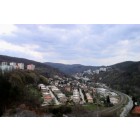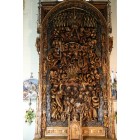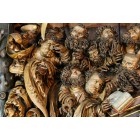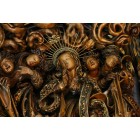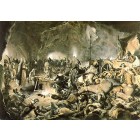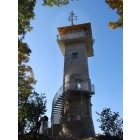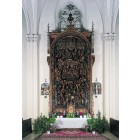Adamov lies on both sides of a deep valley formed by the River Svitava and the Křtinský Stream.
The history of the settlement of this part of the Moravian Karst stretches back to prehistoric times, evidence of which is provided by numerous archaeological finds. The Hallstatt burial site and the blacksmith’s forge at Býčí Skála dating back to the middle of the first millennium B.C. have become world-famous. Metalworking shops in the Adamov area made a great contribution to the development of Great Moravia in the eighth and ninth centuries. Tilt-hammers were in operation on the banks of the River Svitava and the Křtinský Stream in the Middle Ages.
The village of Adamov (Adamsthal) was named after John Adam Andrew Liechtenstein, and the name Adamov can be found in documents from 1679 onwards. Construction of the charcoal ironworks known as Františčina Huť by the Křtinský Stream in around 1743 made a great contribution to the development of the iron industry. Adamov became a village in its own right in 1832. Construction of the Brno – Česká Třebová railway line (opened on 1 January 1849) provided significant momentum for the transition from traditional iron production to the development of engineering.
The ironworks were converted and engineering works for the production of agricultural machinery built in the eighteen sixties. The first automobile in Austro-Hungary was built here in 1888–1889 from a design by the Viennese mechanic Siegfried Marcus. Armaments production developed at full capacity during the Second World War. The Germans destroyed almost the entire plant at the end of the war. Production at the engineering works was later re-established thanks to the tireless work of its employees.
Adamov saw particularly rapid development in the period from the nineteen fifties to the nineteen eighties, with the construction of new housing estates. There was also a significant increase in the population. A network of schools, shops, services and cultural facilities developed in the village. As a result of this boom, Adamov was elevated to town status on 1 July 1964. At the present time almost 5,000 people live here.
The most important historical building in Adamov is the Neo-Gothic Saint Barbara’s Church. The interior of this brick structure features the superb Zwettl Altar, originally from the Cistercian Abbey in Zwettl, Austria. This Late Gothic carving is a unique and valuable work of art.
www.adamov.cz
The history of the settlement of this part of the Moravian Karst stretches back to prehistoric times, evidence of which is provided by numerous archaeological finds. The Hallstatt burial site and the blacksmith’s forge at Býčí Skála dating back to the middle of the first millennium B.C. have become world-famous. Metalworking shops in the Adamov area made a great contribution to the development of Great Moravia in the eighth and ninth centuries. Tilt-hammers were in operation on the banks of the River Svitava and the Křtinský Stream in the Middle Ages.
The village of Adamov (Adamsthal) was named after John Adam Andrew Liechtenstein, and the name Adamov can be found in documents from 1679 onwards. Construction of the charcoal ironworks known as Františčina Huť by the Křtinský Stream in around 1743 made a great contribution to the development of the iron industry. Adamov became a village in its own right in 1832. Construction of the Brno – Česká Třebová railway line (opened on 1 January 1849) provided significant momentum for the transition from traditional iron production to the development of engineering.
The ironworks were converted and engineering works for the production of agricultural machinery built in the eighteen sixties. The first automobile in Austro-Hungary was built here in 1888–1889 from a design by the Viennese mechanic Siegfried Marcus. Armaments production developed at full capacity during the Second World War. The Germans destroyed almost the entire plant at the end of the war. Production at the engineering works was later re-established thanks to the tireless work of its employees.
Adamov saw particularly rapid development in the period from the nineteen fifties to the nineteen eighties, with the construction of new housing estates. There was also a significant increase in the population. A network of schools, shops, services and cultural facilities developed in the village. As a result of this boom, Adamov was elevated to town status on 1 July 1964. At the present time almost 5,000 people live here.
The most important historical building in Adamov is the Neo-Gothic Saint Barbara’s Church. The interior of this brick structure features the superb Zwettl Altar, originally from the Cistercian Abbey in Zwettl, Austria. This Late Gothic carving is a unique and valuable work of art.
www.adamov.cz


